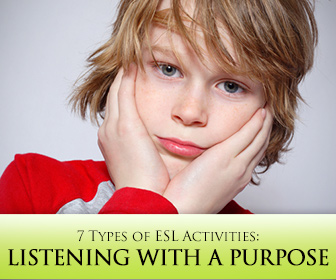Why do we give ESL learners listening exercises?
To boost listening comprehension, of course. Our ultimate goal is to help students understand native English speakers, not only for the mere purpose of comprehension, but also so they may respond accordingly and interact with others. Without listening comprehension, there can be no conversation, no communication.
Now listening comprehension involves a lot more than simply understanding the vocabulary and expressions used. Students must also be able to understand the speaker’s accent and grasp his or her meaning and intention. So, it is clear to see that in the ESL classroom we simply do not listen for the sake of listening. We listen with a purpose. And what exactly is this purpose? Well, there can be several, so as you plan a listening activity, make sure the purpose is clear.

7 Types of Activities for Listening with a Purpose
-
1
Listening for the Main Idea
The purpose of this type of listening is to train students to grasp the main points or general information presented in the audio. Students often get stuck on a detail, a word or phrase they don’t understand and fail to see the bigger picture. So, this is a great exercise for this type of student.
Listening Exercise: Choose a short audio track that presents information that may be easily summarized, like a news report. Breaking News English offers some excellent audio tracks for different levels, like this one for example on bilingualism. Have students summarize the main points in one or two sentences. It is important to clarify that students aren’t expected to deliver details, like numbers, names or statistics but rather express the main point in a concise manner.
-
2
Listening for Detail
Here, the purpose is to train students to grasp specific information, details that are relevant, important or necessary. The goal is to help students obtain the detailed information they may need like hours, dates, names, etc…
Listening Exercise: Biographies tend to have lots of great details. Choose an interesting one – ManyThings.org has several in their People page, as well as cool Places to learn about. Prepare a short list of questions they must read before listening, of the what, when, where, how type. Students listen for these details, then report their answers after the listening.
-
3
Listening for a Sequence
Quite often, students receive instructions in English, information they will need to act on or orders they will need to follow. It is vital that they get the order right, that they understand the sequence correctly and what each step entails.
Listening Exercise: VideoJug has great how to videos, like How to Clean Your Microwave with a Lemon or this interesting one on How to Stop Being Lazy. Have students listen as they write the series of steps, or give them the steps and have them put them in the right order.
-
4
Listening for Specific Vocabulary
Listening activities offer great opportunities to teach new words or review vocabulary previously taught. Here, the purpose is to identify and remember a series of words, which are usually easily categorized, like types of food, sports, animals, etc…
Listening Exercise: Choose an audio track or song that lists words that may be included in a category, like Ylvis’ The Fox (great song for young learners and teens!) You can ask students to listen and write down all of the animals they hear mentioned, as well as the sounds they make. Or create a matching exercise.
-
5
Listening for Cultural Interest
With a carefully selected listening activity, you also have the opportunity to teach students about a special holiday or tradition that is popular with another culture. The purpose is to expose the class to this cultural aspect through a listening activity.
Listening Exercise: Choose an audio track that speaks about a popular American holiday like Thanksgiving. Have students listen and answer some comprehension questions. Then ask: Is this holiday celebrated in their country of origin? If not, is there a festivity that is similar in their country?
-
6
Listening for Attitude and Opinions
Sometimes students have to listen for what someone is really saying, not what they’re literally saying, but what they actually mean. Attitudes, opinions and feelings can all be conveyed in varying degrees from strong disagreement to mild criticism. Advanced students should be able to discern different attitudes and positions, as well as identify how the speaker feels.
Listening Exercise: Listen to this conversation regarding a man’s personal problem. Apart from the actual loss of hair, what else concerns him? (Enduring ridicule, not being accepted as he his, being made fun of, etc…) How does his friend react to this problem? (She’s not concerned, doesn’t think it’s a big deal, etc…)
-
7
Listening for Functional Language
Very often, we teach functional language in the ESL classroom, expressions students can use to accept/decline invitations, give suggestions, give advice, etc… The purpose is to show students how these expressions are used in a conversation.
Listening Exercise: Listen to this conversation between a man whose father has passed away and a friend. What words/expressions does the woman use to express her condolences? (I’m really sorry to hear about your dad…) What else does she say? (My heart really goes out to her.) After the listening, students can practice these expressions in similar conversations.
In most cases, every listening exercise you give your class has its own purpose.
But in most cases, this purpose is clear to you and you alone. Make sure you share what the purpose is with your students. It will give them a fresh outlook on the whole listening experience.
P.S. If you enjoyed this article, please help spread it by clicking one of those sharing buttons below. And if you are interested in more, you should follow our Facebook page where we share more about creative, non-boring ways to teach English.







